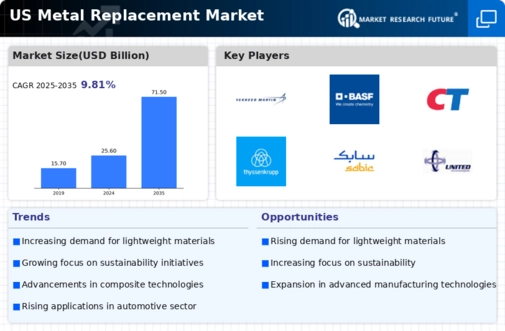The US Metal Replacement Market has been experiencing significant growth, driven by an increasing demand for lightweight materials that can enhance performance across various industries, including automotive, aerospace, and consumer goods. As manufacturers continuously strive to improve efficiency and reduce costs, the competition landscape is becoming increasingly intricate. The material preferences are shifting as companies explore innovative alternatives to traditional metals, leading to a surge in the adoption of metal replacement solutions such as polymers, composites, and advanced materials.
This competitive environment is marked by various players leveraging their strengths in research and development, strategic partnerships, and technological advancements to gain an edge in this evolving market. Additionally, the heightened focus on sustainability and regulatory compliance is shaping business strategies, as companies aim to align their offerings with environmental considerations.Within this competitive landscape, Dow stands out due to its robust presence in the US Metal Replacement Market. Dow's strengths lie in its extensive portfolio of advanced materials and innovative solutions tailored for the metal replacement sector.
The company is known for its expertise in developing high-performance polymers and composite materials that offer exceptional strength-to-weight ratios, making them ideal for applications where reducing weight is critical. Dow leverages its established research and development capabilities to create customized solutions that meet specific client needs. Furthermore, the company benefits from extensive supply chain networks and strategic collaborations with various industries, allowing it to increase its market footprint effectively.
Through constant innovation and a commitment to sustainability, Dow successfully addresses the emerging demands for metal alternatives, reinforcing its competitive advantage within the sector.Alcoa Corporation has made a significant mark in the US Metal Replacement Market by focusing on the production of lightweight metals, particularly aluminum, which serves as an excellent alternative to heavier metals. The company excels in providing a range of products and services that cater to various sectors, including transportation, packaging, and construction. Alcoa’s strengths include its advanced manufacturing capabilities and a strong emphasis on sustainability, which aligns with current market trends favoring eco-friendly solutions.
The company has successfully engaged in strategic mergers and acquisitions, allowing it to enhance its product offerings and expand its market presence. Alcoa's dedication to innovation is evident in its investment in research and development, leading to the creation of new alloys and processes that further the application of lightweight materials. As it continues to drive advancements in material technology, Alcoa remains competitive and plays a vital role in the US Metal Replacement Market.



















